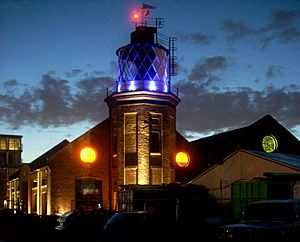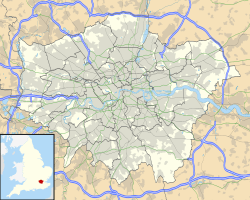Trinity Buoy Wharf facts for kids
 |
|
| Bow Creek Lighthouse at Trinity Buoy Wharf | |
|
|
|
| Location | Leamouth Tower Hamlets England |
|---|---|
| Coordinates | 51°30′27.8″N 00°00′29.9″E / 51.507722°N 0.008306°E |
| Year first constructed | 1863 |
| Deactivated | 1988 |
| Construction | brick tower |
| Tower shape | hexagonal tower with balcony and lantern attached to 1-storey depot building |
| Markings / pattern | unpainted tower, black lantern |
| ARLHS number | ENG-275 |
Trinity Buoy Wharf is a special place in London where the River Thames meets Bow Creek. It's located on the Leamouth Peninsula in Poplar, within the London Borough of Tower Hamlets. This site is famous for its old lighthouse, which is no longer used to guide ships. Today, the lighthouse is home to cool art projects like Longplayer. People sometimes call it the Bow Creek Lighthouse.
Contents
History of Trinity Buoy Wharf
Early Use and First Lighthouse
The story of Trinity Buoy Wharf began in 1803. At that time, a group called the Elder Brethren of Trinity House started using the site. Trinity House is an important organization that looks after lighthouses and navigation in England.
In 1822, a seawall was rebuilt at the wharf. This wall helped protect the land from the river. The site was used as a maintenance depot. This means it was a place where equipment was stored and repaired. It also held many buoys. Buoys are floating markers that help ships navigate safely on the Thames. The wharf was also a place where lightships could dock and be repaired. Lightships are like floating lighthouses.
The first lighthouse at Trinity Buoy Wharf was built in 1852. It was designed by James Walker, who was an engineer for Trinity House. This original lighthouse was taken down in the late 1920s.
The Second Lighthouse and Famous Scientists
A second lighthouse was built between 1864 and 1866. This is the lighthouse you can still see today. It was designed by James Nicholas Douglass for Trinity House. This lighthouse was used to test new lighting systems. These systems would then be used in lighthouses all around England and Wales.
A very famous scientist, Michael Faraday, even did experiments there. Both lighthouses were also used to train people. These people were learning to become lighthouse keepers. Lighthouse keepers were the brave individuals who lived in lighthouses and made sure the lights kept shining.
Trinity Buoy Wharf Today
Changes in the Late 20th Century
In December 1988, Trinity House stopped using the wharf. The area was then bought by the London Docklands Development Corporation. This group worked to improve and develop the old docklands area of London.
In 1998, a new group was formed called the Trinity Buoy Wharf Trust. This trust was given a very long lease, 125 years. Their job was to hold the land for the people of London. A company called Urban Space Holdings Ltd then took control of the site.
A Hub for Arts and Creativity
Since then, Trinity Buoy Wharf has become a lively center. It is now a place for arts and cultural activities. Many improvements have been made. There are now studio spaces for artists. Some of these studios are built in a very unusual way. They are made from old shipping containers! There are also spaces for exhibitions.
Urban Space Holdings created "Container City" in 2001. This was a complex of studios and offices. It was made from recycled sea shipping containers. The first Container City project used 80% recycled materials. It took only five months to build and just four days to put together.
Container City became very popular. So, in 2002, "Container City 2" was finished. This added 22 more studios across five floors. It has a bright, colorful ziggurat design. Another part of the Container City complex is the "Riverside Building." This building is next to the Thames. It faces The O2 dome. This building also provides 22 more studio spaces for artists.
Education and River Transport
In November 2005, the University of East London opened Fine Art studios at the wharf. In September 2009, the university opened two dance studios there too. These are part of the Institute of Performing Arts Development.
Faraday School is a primary school that opened in September 2009. It is a not-for-profit school.
The wharf is also home to Thames Clippers. This company runs river bus services on the Thames. They have offices and keep all their boats at the pier there.
Historic Boats at the Wharf
In April 2013, a former tugboat named Swiftstone moved to Trinity Buoy Wharf. Volunteers began to restore this historic vessel. You can sometimes see this work happening during the Thames Barge Driving event.
In 2016, the Trinity Buoy Wharf Trust bought two more historic tugboats. These were the Knocker White and the Varlet. They were bought from the Museum of London Docklands. Both of these tugboats are listed on the National Register of Historic Vessels. This means they are important parts of the UK's maritime history.
Images for kids






